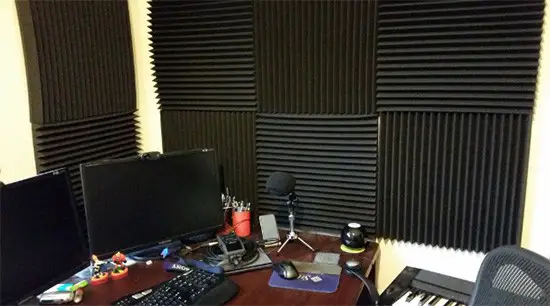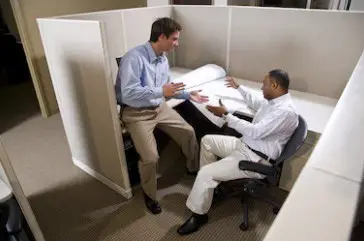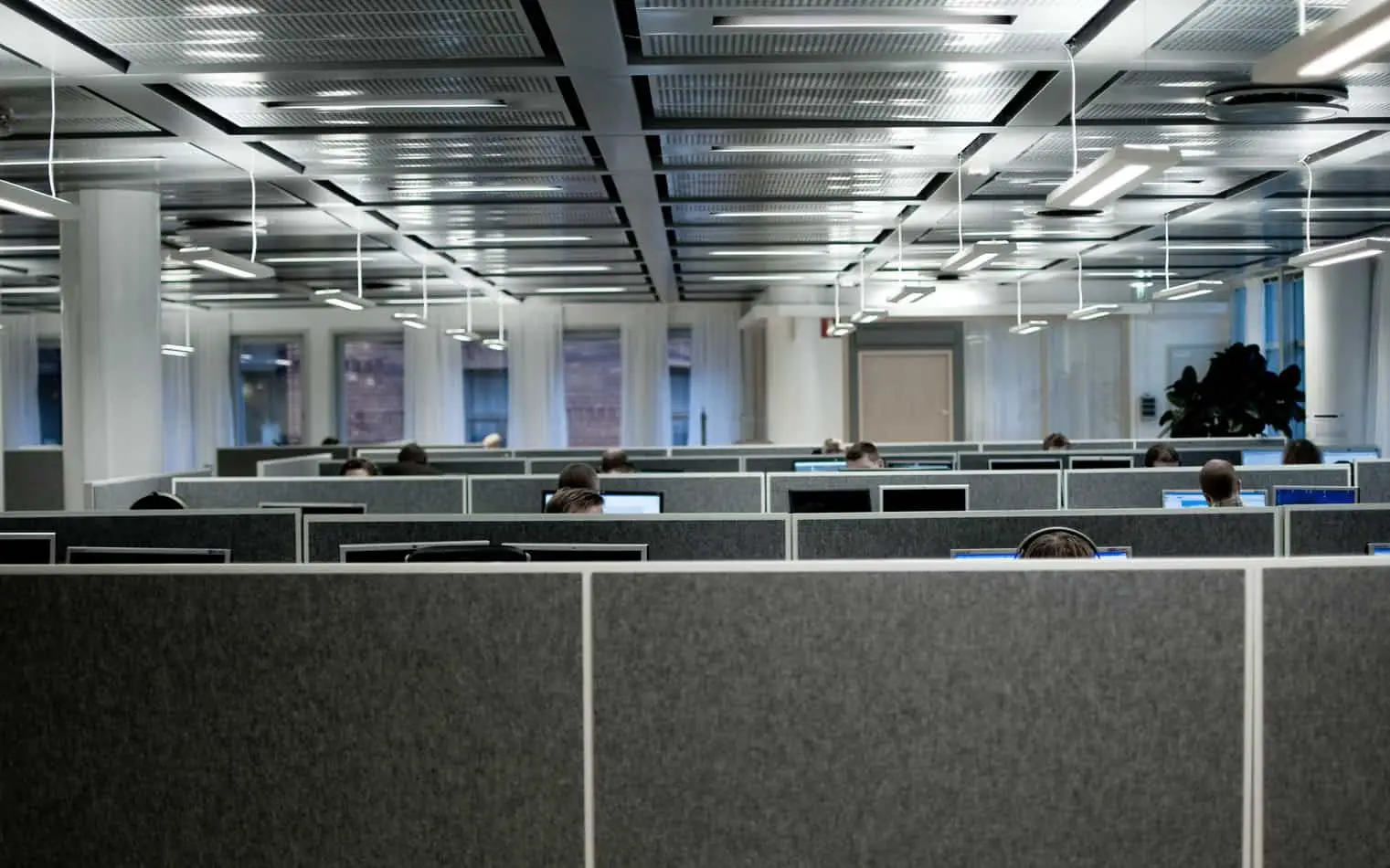Have you ever worked at a job filled with cubicles? Cubicles are mostly used due to how easy they are to rearrange in the workplace.
You can literally relocate, remove, or add little offices to best suit a business. This also means that your employer can cram as many workers as possible into one small space.
This isn’t always a good idea if you want to keep the noise at tolerable levels. I used to work in a call center where all people did every day was talk on the phone and among themselves.
Sometimes there was so much talking and noise going on that it would actually affect the quality of my calls from customers.
One night I decided to learn about cubicle soundproofing. I knew there was no real way to eliminate all the noise, but I was still reluctant to find something that could help me work in peace.
Here are some of the best techniques and ways that I learned to make your cubicle quieter.
Place Acoustic Panels on the Inside of Your Cubicle Walls

Most cubicle walls are usually hollow and thin. This creates a path that noise can easily travel through.
By adding acoustic panels to the insides of your cubicle walls, you will indirectly be thickening your cubicle. The thicker you can make your cubicle walls, the better.
These acoustic panels from amazon are well priced and will work perfectly for this situation. In order to stick the panels on your cubicle wall, you will need to use hanging strips like these ones.
Try to cover up your cubicle walls as much as you can with the acoustic panels for the best results.
Installing these acoustic panels will help absorb sound and reduce the amount of echo in your workplace. Installation is very easy if you use the adhesive hanging strips that I recommended. Installation is as follows:
- Measure your cubicle to see how much acoustic panel you will need.
- Cut the acoustic panels to the correct lengths based on your measurements.
- Mark Your cubicle in the places where you will be placing the panels.
- Take your hanging strips and peel off the plastic covering the adhesive backing and stick them onto your acoustic panels.
- Peel the other end of the adhesive strips to expose the other sticky side.
- Place your acoustic panels onto your cubicle wall according to your preference.
I like to place them in alternating vertical and horizontal positioning because I personally think that it looks nice.
Don’t Forget to Block Gaps and Cracks
Once you have installed your acoustic wall panels, make sure to look around for any gaps, cracks, or holes in your cubicle area.
If you have any gaps, then I would advise you to cover them up with any extra acoustic paneling that you have left. Cut the acoustic foam into strips or small squares and stuff them inside any holes or gaps.
Leaving exposed gaps or holes is one of the biggest problems because it is a free highway for noise to travel through.
Big gaps can literally render all the work you have done useless. It doesn’t matter how nicely you installed your acoustic panels.
If there is a hole at the bottom of your cubicle, then noise will be able to pass through.
Extend the Height of Your Cubicle Walls

Adding some extra height to your cubicle will help deflect and reduce quite a bit of noise coming from the other cubicles in your area.
There are a few problems with this method that I want to point out.
If you work for a strict corporate company like I did, then adding extra height to your cubicle may be off-limits. Every office will have its own rules and regulations that must be adhered to.
Another potential underlying problem is the fact that they can be knocked off with enough force.
I always wanted to add cubicle wall extenders like these from amazon, but my manager told me it was against our company policy because it can be a safety hazard if they were to knock down.
They are fairly easy to install. You will just need to measure the thickness of your cubicle walls to make sure you will be able to clamp on the extenders.
If you have better luck than me, then you could install these extenders on each side of your cubicle for added sound deflection.
Add a Rug or Carpet to Your Cubicle Space
Most offices usually have some kind of cheap carpet installed. It’s just soft enough to pass as carpet, even though it feels like you are walking on a wooden floor.
So what’s the big deal about changing up the flooring in your cubicle? Adding some extra carpet or a rug to your cubicle space will help dampen the sound and reduce echoes.
Instead of noises bouncing off the cheap floor, they will be absorbed into the thick rug or carpet.
Just be careful not to use something too thick because it may cause static electricity buildup while you are rolling around in your chair.
Adding an extra layer to your cubicle’s floor will be a small addition to making your cubicle quieter. Just remember that every little change counts towards soundproofing a cubicle.
Adding to your cubicle flooring alone won’t net you a silent cubicle. Once you start incorporating other techniques and methods to soundproofing your cubicle is when you will begin to notice all the differences.
Incorporate a White Noise Machine in Your Cubicle

The next step to helping you work in a quieter environment is to mask or block out the excess sound.
There are actually devices called white noise machines that are intended just for this.
White noise is simply noise containing many frequencies with equal intensities. White noise is mostly used to mask other sounds that are going on since it contains so many different frequencies.
I recommend this portable white noise machine from amazon to bring with you to work. It has very high ratings and is small enough to be placed on your work desk. It is about the same size as a normal-sized iPhone.
The best part about this one, in particular, is that it comes with a volume dial and a timer.
It doesn’t have as many sound options to choose from as some other brands, but it gets the job done just fine. Installation is easy.
Simply place it on your desk near a power source and plug it in. If you lack a power source to plug the machine into, then you can put batteries inside of it instead.
Use Noise Cancelling Headphones at the Office

The main attribute you will want to look for in a nice pair of noise-canceling headphones is that they are comfortable and practical.
It will do no good if you have a nice pair of headphones that are very comfortable but barely block out any noise.
I have searched for lots of different headphones and have found that these Bose noise canceling headphones are some of the best headphones you can get.
Not only are these headphones excellent for noise canceling, but they are also capable of playing music via a Bluetooth connection. I actually have a Bose sound system, and it is excellent.
Bose is a very well-known and trusted brand. There should be no worries at all as to if the product will be good or not. Bose has worked hard at creating a reputable brand which is why I have no problem recommending them.
Since I worked at a call center, I wasn’t able to use headphones at all. If I were able to use headphones, then I would most definitely use these.
Coworkers at my job have been reprimanded when they used earphones to listen to music in between calls because it was considered a distraction and would hinder work performance.
Change Your Keyboard at Work
A cheap and easy way to help you make less noise during work is to invest in a few quiet office supplies.
If you have a desk job, then you probably spend most of your day hammering away at the keys on your keyboard. There are keyboards on the market that are specifically designed to make less noise when being used.
I actually use this keyboard because it is perfect for office use. It is very quiet and is also spill-resistant. Two of the most important characteristics that you need in a keyboard for working in a cubicle are.
This keyboard is manufactured by Logitech, which is a very trusted and well-known brand for computer accessories.
This brand is tried and proven, and I highly recommend this model since it is very cheap and effective.
How can changing out a keyboard help reduce noise? Some keyboards are very loud and obnoxious when used. If you type quite a bit at your job, then this is one of the best items you can replace.
A lot of people don’t think about changing their keyboard at work. This is because they are too worried about the noises others are making around them.
Take a few minutes while you are at work one day to listen to all the noise that is generated from your keyboard while you are working. You will be surprised at how much noise it actually poses in your day-to-day routine.
This is one of the few items that I was actually able to use at my workplace with proper approval.
Talk to Your Manager or Hr Department About Noise Levels

Something else you can do is bring up the problem with your supervisor or human resources department.
If you portray the problem as the excess noise causing you to not perform as well as you can, then there is a high chance for changes to happen.
Most employers are number driven and will do almost anything it takes to increase sales or numbers.
If there are a few people near your cubicle who are excessively disruptive during working hours, then your manager should be able to address them anonymously so that you don’t have to worry about complaining about coworkers.
Just keep an open mind when approaching your problem in this fashion.
Your manager may ask if you want to move instead of confronting the noisy coworkers. Be prepared to be relocated if it must come down to that.
Final Thoughts
When soundproofing your cubicle, there are many different approaches you can take.
Talking to your manager or human resources to be relocated, installing acoustic panels, using white noise devices, using noise-canceling headphones, or whatever other methods you may use are mainly determined by your employer.
If you are able to incorporate many of the methods I have suggested in the above article, then there is a good chance that your cubicle will be a lot quieter than it was before you made any changes.
Sometimes a few little tweaks to your cubicle are all you really need. I personally asked to be relocated on my floor to a quieter area.
This relocation was enough for me to see a benefit. I also added a few acoustic panels to the inside walls of my cubicle after I was relocated.
This helped a lot with the echoes from others around me. The last thing I did was change my keyboard to a quiet keyboard.
This helps in more ways than you can imagine. Not only was my typing quiet, but the keys were nice and soft when pressed down on.
Installing acoustic panels, being relocated, and switching out my keyboard have all been very effective for me at my workplace.


